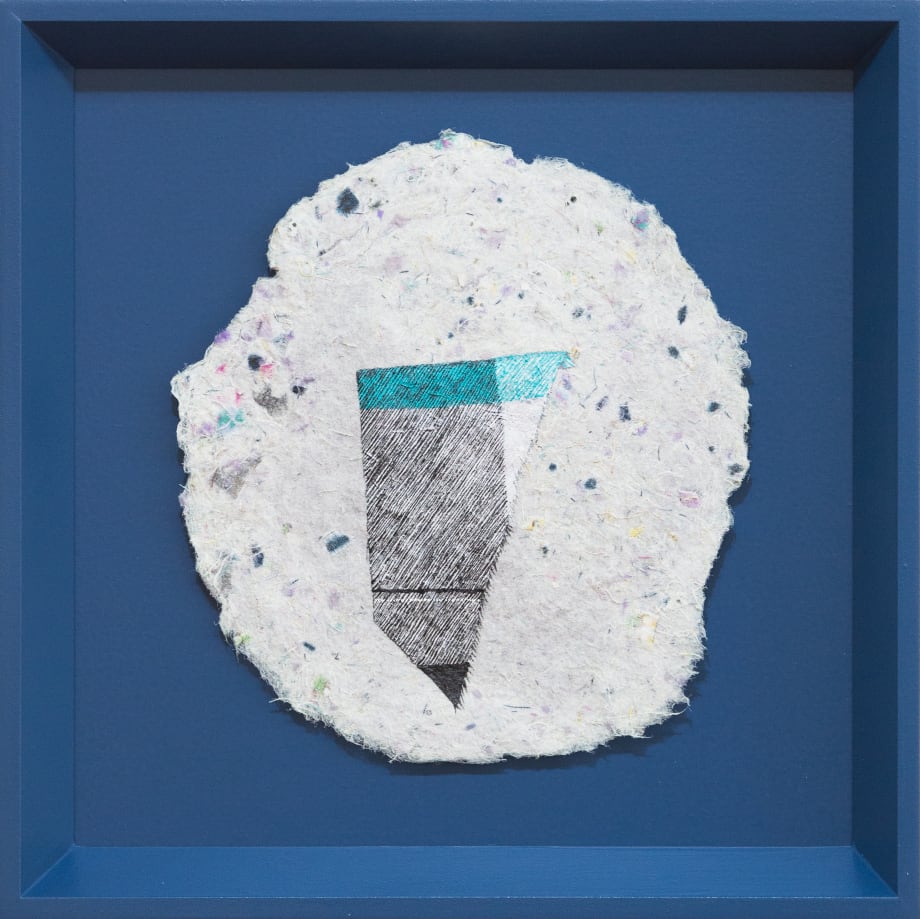An autobiographical rag picker of sorts, I collect our redundant domestic textiles, and in a homage to the commodity and history of paper; (as both ancient and contemporary) I memorialise these often mundane fragments of presence in a pragmatic metaphysics of destruction and renewal. Bringing awareness to temporality and waste, these emotionally charged works expose how the matter of daily life disappears and reappears; bearing the traces of their previous experience in entropic collages of form and pattern.
Marita Hewitt’s latest exhibition Material Efficiencies is made up of two distinct series of works on handmade rag paper. These works emerged out of Hewitt’s ongoing interest in the history and processes of pre-industrialised paper production, and the ensuing impact of the material on the development and definition of drawing and illustration. The artist’s own paper-making process is both arduous and time-consuming – a single sheet of rag paper taking hours of labour, and all of this before Hewitt even begins to paint. She then works to carefully capture in watercolour the patterns and textures of the same fabrics used in the paper-making, devotedly detailing every imperfection.
Flux Matter(s) is a suite of compositions constructed from a miscellany of fabrics, each with their own unique and tactile history. These large works hold a particular weight; a gravity that is evident both in their physicality and in their corresponding emotive qualities. The paper is thick and heavy, folding over on itself or creasing outward in a way that is distinctly sculptural. With titles that reference their respective months of making, collectively the works function as a sort of lyrical calendar, an unconventional physical mapping of time, whereby the visible scraps of fabric and painted elements provide traces of the artist’s own personal and poignant family histories.
May brings together odds and ends from previously sewn items, including a houndstooth silk from a dress designed and made by the artist and sold in St Kevin’s Arcade on Auckland’s Karangahape Road over a decade ago. July features a gingham sleeve from a shirt the artist wore for years while gardening or painting, which became so threadbare it finally tore through. A large cotton scrap appears in August, left from a dress Hewitt made from fabric found amongst her mother’s collection. Still August includesthe thick cotton curtaining that originally hung in Hewitt’s parents’ lounge, which her mother replaced and passed on to Hewitt, who hung them in her bedroom. Evidence of a linen shirt bought for her partner at a local op shop some time ago, and which he never wore, is found in September. And finally October brings the dotted cotton shards from a playsuit made by the artist’s mother for Hewitt’s own daughter, and alongside it the striped cotton from a dress that was one of the last things Hewitt’s mother was in the midst of making before she passed away, the final adjustments made by another family member so that it could be worn to her Oma’s funeral.
Remnants is a sequence of works whose origins are just that – each made from scraps or remnants of material, which Hewitt has so carefully and efficiently salvaged from the paper-making process. These small works appear almost as precious gems that seem to epitomise Hewitt’s practice; her appreciation of everyday materials, a delicate and meticulous approach to drawing and making, and her ongoing commitment to environmental sustainability in both her life and work.
